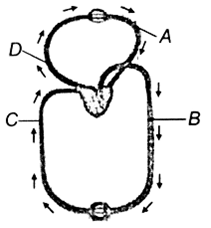Person with blood group AB is considered as universal recipient because he has
-
Both A and B antigens on RBC but no antibodies in the plasma
-
Both A and B antibodies in the plasma
-
No antigen or RBC and no antibody in the plasma
-
Both A and B antigens in the plasma but no antibodies
Both A and B antigens on RBC but no antibodies in the plasma
Both A and B antibodies in the plasma
No antigen or RBC and no antibody in the plasma
Both A and B antigens in the plasma but no antibodies
A.
Both A and B antigens on RBC but no antibodies in the plasma
Blood group AB is universal recipient because the person with AB blood group has both A and B antigens or RBC but no antibodies in the plasma. Other blood groups and their genotypes are
|
Blood Group |
Antigen(s) Present on the RBC |
Antibodies Present in Serum |
Genotypes |
|
A |
Antigen – A |
Anti – b |
AA/AQ |
|
B |
Antigen –B |
Anti – a |
BB/BO |
|
C |
None |
Anti – a and b |
O |






